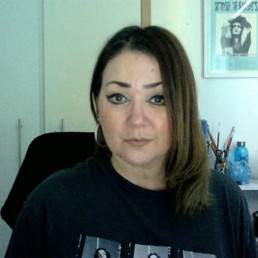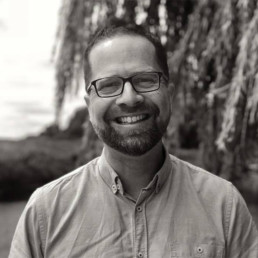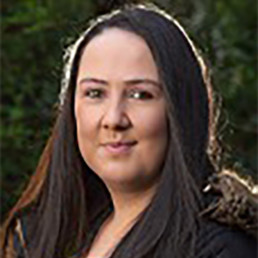“Andrew Tate is a father figure to me” - lessons learned from talking to young people in schools

Written by Bold Voices
Bold Voices is an award-winning social enterprise preparing and empowering school communities to recognise and tackle gender inequality and gender-based violence through the delivery of educational talks, workshops, training and resources for young people, teachers and parents.
On January 3rd, the Bold Voices team arrived for our first staff training of the year. We love delivering staff training in schools, and we were excited to be back, if slightly unprepared for the early start and January rain. The session ran smoothly and the staff were engaged and passionate, all seemed as usual until we asked if there were any questions. Dozens of anxious hands shot up and they all had the same question – “what can we do about Andrew Tate?”
It wasn’t a surprise to any of the team, especially after the most recent news over the Christmas break, but the number of times his name has come up in schools in January has been unprecedented.
Back in July 2022 we began to hear students talk about Tate, and in order to get ahead of what we could see was a growing issue, Bold Voices released our Parent and Staff Toolkits to equip adults with the skills and confidence to have conversations about the ‘King of Toxic Masculinity’ with the young people in their lives. As the education sector catches up with the fact that this popular figure is not going anywhere anytime soon, we have seen a whole range of approaches to dealing with his popularity amongst teenage boys.
One strategy which we’ve seen is the blanket ban – sanctions for anyone who says his name in school. Another approach is whole school assemblies to speak about the harms of his content and messages. The young people we’ve spoken to don’t feel this works; they either say they feel silenced, or that the school is making too much of it. It is completely understandable that this is how many schools are responding. We certainly don’t have all the answers at Bold Voices, and we are always keen to hear back from other educators and parents who have found effective ways to address this issue (please let us know!) but for now we are encouraging schools to focus on one method that we know can have an impact: starting a conversation.
However, the reality is, these conversations are not easy. Here is a snippet of how they normally go:
“Miss, can I ask you a question? What’s your opinion of Andrew Tate?”
“Well, I’m much more interested in your opinion – what do you think of him?”
“He’s a top G miss. He teaches men how to be men. He makes money. He gets females. He’s a fighter. He is a traditionalist. He has four Bugattis. Those trafficking charges are lies. Those things he says? Taken out of context. Miss, it’s the Matrix. He’s a father figure to me.”
These conversations don’t always feel possible, or respectful, because these young people have internalised the message that anyone arguing against Tate is an idiot, hasn’t woken up to the truth, or they’re simply wrong. This makes it much harder to do our jobs – but we have seen success. In a school which had banned any mention of his name amongst pupils, when we opened up a conversation in a classroom, the feedback we received afterwards was: “I thought Andrew Tate was good but I realised what he does and all the hate against women.”
So what can we do to make more of those conversations successful? How can we move from fear of even starting a conversation, and those that go nowhere, to helping young people to choose for themselves if they want to continue to support Tate and his harmful messages?
Our response is three things (and they’re not easy):
STEP 1: TALK ABOUT HIM – BUT DON’T CONDEMN HIM
This can feel extremely difficult when the messages Tate puts forward are so explicitly dangerous and incite violence, but the more we condemn his words, the more we play into a right or wrong binary that pushes defensive teenagers even further away. Narratives around the Matrix incorporate the idea that there is a “great lie” going on, and figures like Tate (and Trump and other populists who brand themselves as anti-establishment) use this condemnation to push the idea: “that’s what they want you to think”. Break out of this binary by opening a dialogue and empowering young people to see all sides and opinions and to have the autonomy to make their own decisions about who they follow and believe. The aim should not be to have our children believe everything we believe because it’s scary when they don’t; we want to raise a generation of critical thinkers who can form their own opinions.
STEP 2 – MAKE ANDREW TATE UNCOOL AGAIN
This ties into avoiding condemnation – when we stand up and tell young people he is dangerous we give him notoriety and power. Andrew Tate has branded himself as the antidote to cancel culture, so his popularity is not tied to his morality. Not only that, his messaging around gender roles mean that he can discredit those who speak out against him with misogynistic myths – case in point, I asked a student if he would stop liking him if Tate was convicted for the trafficking charges and he said “well, the women are probably just lying for money and attention.”
Attempts to laugh at Andrew Tate have been more successful in damaging his reputation than pointing out how dangerous he is. The closest to this that I’ve seen is this twitch streamer’s video and Greta Thunberg’s infamous tweet. What I don’t like about these tactics is that they use old tropes of emasculation to put a pin in his puffed up performance of masculinity. Relying on his tools to tear him down won’t create meaningful change in the long run (we’ll just see a newer version of him spring up to his place).
STEP 3 – ASK THE RIGHT QUESTIONS
This brings us to the most important point – we need to change what questions we’re asking about Andrew Tate – instead of asking “what can we do about him?” we need to ask “what is it about him?” And “what is it about this current climate that allows his version of masculinity to thrive?”
His brand of masculinity is what draws people towards him: words like traditional, realist, role model for how to be a man. To most adults he looks like a cartoon of all the most ridiculous tropes of toxic masculinity; the cars, the money, the ideas about mental health. The alleged trafficking of women, the misogyny. So when we’ve looked at why he’s so popular the next question needs to be, what is the context and climate that means he is appealing?
When having these conversations I like to zoom right in, then all the way out. Instead of arguing his actual points with evidence or debating his intentions, I ask questions about what he represents, then look at the bigger picture, and ask why is that appealing right now?
The context in which boys are gravitating towards Andrew Tate is one in which they feel victimised and powerless. As an educator in the gender-based violence sector this can feel frustrating. But ignoring it and saying, “suck it up”, men have had power since the beginning of time, is not helping anyone.
Conversations around violence against women have completely transformed since I was at school less than 10 years ago. In a way that we can see paralleled with the movement for racial justice, conversations around gender-based violence have been radically shifted by events of the past decade: The #MeToo movement, Everyone’s Invited, Ofsted investigations, Sarah Everard’s death and many more. It’s confusing for young people.
Girls, trans and non-binary pupils have more awareness and knowledge than ever (thank you TikTok) about the ways in which they are victimised within a culture of gender-based violence. And they still suffer many different forms of this. But boys feel under siege too. They feel more under threat of being falsely accused than ever. Andrew Tate offers them a different narrative from the one in which they feel they’ve been cast as the baddies. There are no alternative models of masculinity on offer. We go into schools and tell young people that what Andrew Tate puts forward is an unrealistic stereotype of masculinity that ultimately harms everyone. Sometimes they see that, but when we exist in a system that punishes those who don’t fit a stereotype, we construct a reality where it is preferable to be an Andrew Tate rather than a man who can express his emotions and show weakness and vulnerability.
The quote at the beginning says it all. “Andrew Tate is a father figure”. This is how teenage boys feel when there aren’t any other role models for masculinity that seem valuable in today’s world.
The options are; see the problem with masculinity and try your best to not embody it, or go sit with Andrew, the realist, who can show you how to stop apologising for being a man in a world where stereotypes are just ‘the way things are supposed to be’.
As educators on this subject we can tell you that having these conversations on the ground is hard work. It’s a painful slog that feels unrelenting and sometimes futile. Watching boys copy his physical stance, treat me with suspicion, shout down my logic and questions and cling to their idolisation of him makes me realise something; they are clinging tightly because he makes them feel safe and understood. And taking that away is difficult and can feel cruel when we aren’t offering good enough alternatives. If it was anybody but Tate, I would never question a vulnerable year 9 boy’s father figure and role model. I’m so glad he has that. I wish it wasn’t one who would teach him that depression isn’t real, that he should value women as possessions, and that his worth is measured in what he can win, and how dominating he can be. I want to give him a hug.
LET’S COME BACK NOW TO OUR THREE SOLUTIONS.
1- Talk about him, don’t condemn him. At Bold Voices we will keep going into schools and having these conversations. And if you have young people in your life please use our toolkits to start having these conversations too. This part is the intervention and it’s more necessary than ever. The aim is not to condemn and create a right or wrong, it’s to open a dialogue where there is more than one narrative to choose from.
2- Make Tate uncool – but not him specifically and not through emasculation. Instead through promoting other role models of masculinity who seem more appealing than Tate. We look to people like Marcus Rashford, Stormzy, and Steph Curry (get in touch if you have others you promote!)
3- Look at the conditions that make Tate popular. Ask questions and don’t stop asking.
WANT TO LEARN MORE?
- Toolkit: How to Talk to Young People About Andrew Tate – Bold Voices
- Article: (7 minute read) How to respond to boys inspired by Andrew Tate Mark Roberts – TES
- Article: (5 minute read) Andrew Tate: How schools are tackling his influence Alice Evans – BBC
- Article: (6 minute read) What is going on with this Andrew Tate hand gesture? Sophia Smith Galer – Vice
HOW CAN WE HELP?
Bold Voices is an award-winning social enterprise preparing and empowering school communities to recognise and tackle gender inequality and gender-based violence.
Resources: Activities for the classroom, toolkits, blog posts and lesson plans for discussing gender inequality and gender based violence. Sign up to be the first to hear about new resources we create through our newsletter.
In Person Talks and Workshops: Discover our staff training, pupil talks and workshops, led by experienced facilitators and delivering on key topics relating to gender inequality and gender based violence.
Belonging on Purpose

Written by Andrew Morrish
Andrew is a former headteacher and founder trust CEO. He has also been an NLE, inspector, LA adviser, chair of governors, and trustee, so he has seen it from all angles. Andrew is now Director of Makana Leadership Ltd, a consultancy he founded in 2020, and author of The Art of Standing Out (John Catt). Andrew also co-founded Headrest during the pandemic, a free wellbeing support service for headteachers.
One of the greatest challenges during my two decades as a headteacher was trying to build a culture of belonging.
For many schools, this becomes the holy grail. It’s easy to understand why. Research tells us that if staff feel isolated and vulnerable at work – that they feel as if they don’t belong – they are more likely to lack engagement, motivation, and commitment. As a result, productivity declines, and we see this often in the lowest performing schools. On the flip side, where there is a strong culture of relational trust for example, the likelihood of this impacting positively on student outcomes is significantly higher.
Leading change must always lead to impact (in this case a culture of belonging). Just because you think you are going about your business of leading, it doesn’t necessarily mean you are changing anything. Leadership without impact is not leadership at all. It’s just you being busy.
So in order for change to lead to meaningful impact, it needs to be done on purpose. It also needs to be done from purpose. The two are very different. Let’s see how.
When we lead from purpose, we do so authentically from a position of strength. The main source of that strength comes from within; our core values and beliefs – the stuff that drives and motivates us. These are the things that we choose to do, not because we have to, but because we want to. These beliefs also determine whether staff are more likely to feel as if they identify with you and the team, department, phase (or school even) that you lead.
In order to lead successfully you need to know that everything starts and ends with you. Who you are, what you believe in, and why you do the things you do. This is at the heart of what it means to lead from purpose.
When we lead on purpose, we do so deliberately, with accuracy, and care. We’ll take both of these in turn in a moment. First though, we need to appreciate that leadership – authentic and purposeful leadership in particular – is too important to lead to chance. It doesn’t just happen. We need to plan for it and to think deeply about when, where, and how it happens.
It’s a bit like going shopping. You have to know what it is you need to buy (make a list), and then when you’ve bought it you then need to know how best to combine them in order to turn the items into something meaningful (i.e. meals). This is the whole point of doing the weekly shop – to keep yourself and others sufficiently nourished. Leading is no different.
The process of shopping (as with leading) is merely a means to an end. It needs to lead to something. And if we just left it to chance, who knows what we’ll up with. We most likely won’t starve, but it will hardly be enriching and enticing.
When planning to lead well, leaders need to take care when thinking about their actions and behaviours. Careful leaders are ethical leaders, and – as would be expected – care passionately about the things they believe in. More importantly, they care passionately about the beliefs of others in a diverse workplace.
If we do this all of the time, consistently, constantly, and convincingly (my three habits of authentic leaders) chances are these behaviours will become normalised. They become habits. Habits help us ensure that we do things automatically and precisely. They are done right each time, without thinking, such as driving to work, talking to a parent, or giving feedback to a pupil.
Precision is essential but only if it’s accurate, for it is this that ensures we are being precise about the right things. It’s accuracy over precision every time.
You can be as precise as you want about sticking meticulously to the speed limit or the ingredients in your recipe. But if you are heading in the wrong direction, or adding salt instead of sugar, then you won’t achieve much.
Accurate leaders do the right things on purpose, and from purpose.
Authentic leaders are accurate leaders because it is done with care. They know that people rarely succeed unless there is purpose behind their actions. It is this sense of purpose – and associated success – that is the bedrock to belonging.
Success is the residue of belonging. It’s what’s left behind long after everyone has gone home. It sticks and lingers and is what makes people keep coming back for more. Success is permanent.
And by success, I don’t mean Ofsted banners outside the school gates, or fancy logos on headed paper. I mean a true sense of deep accomplishment and belonging where self meets the world, the interface of which we call the workplace.
It is of course the place where young people to go to learn, but it’s also the place where we, as adults work. It’s where we spend most of our waking moments, so it makes sense to at least feel as if we belong there.
As poet and philosopher David Whyte says (quoting Blake’s words), “To have a firm persuasion in our work – to feel that what we do is right for ourselves and good for the world at the exact same time – is one of the great triumphs of human existence.”
It is also one of the greatest challenges of school leadership. Known strategies such as allyship, empowerment and mentorship all make for great starts. In my new book, The Authentic Leader, I tell the inspiring true story of Dikgang Moseneke, a man who knew all about the value of these. But as Dikgang reminds us, unless all of these things are done through ‘collective agency’, on and from purpose, we may end up falling short when it comes to providing one of the most fundamental human needs: belonging.
Tidying up: a lesson in values from the Japanese football fans

Written by Esther Cummins
Course Leader MA Education (online) at Falmouth University
Every four years, the World Cup offers schools a theme around which to focus their learning. The links to geography and sport are obvious, but further learning opportunities include the application of probability, time zones, languages, and textiles. Unexpectedly, this year we have all been shown an example of community values from the Japanese fans and players.
The pictures and videos that have circulated of spotless dressing rooms and tidy stadiums show the communal value of respecting your hosts held by the Japanese visitors. This representation of fans and players is a far cry from the embarrassing behaviour that is often seen in media reports about English fans. So why is there such a difference in the behaviour?
Interviews with Japanese fans have commonly cited the term, “atarimae”; the English translation is similar to ‘obvious’ or reasonable. From a young age, children take on the responsibility of cleaning their schools before they leave for the day. This task is not an ‘add-on’ to be squeezed into the curriculum if there is time. It is not a quick tidy-up or asking the students to put their chairs on the table. Without this cleaning, the school would be dirty.
I have cleaned schools out of necessity; in a small school where I was a senior leader, the headteacher and I were the contingency plan when the cleaner was absent. I have asked children to wash some toys at the end of a school term. I have asked university students to put their rubbish in the bin. But I have not worked in an environment where it was a regular expectation for the educators or the students to maintain the tidiness and cleanliness of the learning environment.
Within our society, we pay cleaners and caretakers less than we pay our educators. Perhaps this mentality is a hangover from the British Empire, where the wealthy expected their servants to clean up after them. Our values impact our behaviour (Steg et al., 2014), thus it is important to consider what and who we value. When we litter or leave a mess, we are saying we are more important than the environment or those that are paid to clean. Is this who we want to be as educators, and as a nation?
Respect is part of who we are; indeed, “The teaching of respect for others is not only one of education’s more important objectives, but in its absence little, if any, real learning can take place” (Ungoed-Thomas, 1996, p152). If we are viewing our pupils as the citizens of the future, we need to think carefully about the values we are instilling in their lives. Saying we are respectful is different to being respectful; we need to model and insist upon behaviour that mirrors this value.
This issue is about more than tidying up. It can be applied to any of our inclusive values, our desire for equality, and our drive for fairness. If atarimae means stating the obvious, which behaviours and values do we need to instil in our classrooms, from nursery to university, that creates a respectful community we are proud of?
We are yet to see who takes home the trophy, but I know whom I see as the winners of this year’s tournament.
Working with Gypsy, Roma, and Traveller Young People

Written by Karen Self
Karen joined the NYA in late 2020 as a Youth Work Specialist. She is a JNC professionally qualified youth and community worker and qualified trainer. Karen has worked in the youth and community field for over 25 years, including managing and leading activity across a range of sectors and environments.
Karen Self, Learning and Development Manager, National Youth Agency, describes why she is so passionate about the new Gypsy, Roma and Traveller CPD course for youth workers and others working with young people looking to ensure their services are inclusive.
‘’The most important piece of advice for any youth service hoping to engage with young Gypsies, Roma and Travellers is to go out and meet and talk to the young people, their families and others in the community.’’ This statement, from our recently launched CPD course ‘Working with Gypsy, Roma, and Traveller Young People, might seem obvious if you’re a youth worker, but how well do you really understand Gypsy, Roma, and Traveller communities?
Perhaps you’re already working with Gypsy, Roma, and Traveller young people but not realise that you are because, contrary to the common misconception, some 78% of Gypsy, Roma, and Travellers in the UK live in permanent bricks and mortar housing (according to the 2011 Census)
Furthermore, do you fully appreciate the challenges the Gypsy, Roma, and Traveller communities face?
This question takes me back to my work directly with young Roma people, as well as managing teams that have worked with the local Roma community. I recall that it was essential that the team gave their absolute commitment to building trusted relationships within the community over a period of months, even years. Yes, we faced many challenges, the young people we connected with were often discriminated against by peers and members of the community, a mutual lack of cultural understanding often led to conflict with other young people, there were also worries about our intentions and our own concerns about the risk of exploitation of Roma young people by others; however, over time the work flourished, and we witnessed many successful outcomes for young people. We found that by focussing on their similarities with other young people – like football, music and dance – we were able to improve relationships and understanding amongst young people and by working with partners in the community and in the local secondary school we were able to tackle some of the more complex issues.
Our work with a group of Roma young people was successful because the lead detached youth worker was knowledgeable about the communities they worked alongside; they always strove to understand their needs and experiences and were committed to developing trusted, yet boundaried, relationships and instilled these values in their team of detached youth workers.
Would a course have improved the team’s and other professional’s knowledge and understanding? Most definitely! That’s why I’m so passionate about the two Gypsy, Roma, and Traveller CPD units the National Youth Agency has produced alongside ODET (Open Doors Education & Training).
The second course provides insights into successful activities to engage young people from the Gypsy Roma and Traveller communities, including.
- The importance of youth work with the community and effective approaches to engagement, social inclusion outreach, diversity, integration, and multi-agency work all with a focus on promoting pride and the visibility of cultures.
- How to identify and analyse participation barrier challenges.
- Examine good practice examples in youth work settings and how to develop inclusive practice in their own settings.
Including case studies, useful templates, and a wealth of resources, the ‘Working with Gypsy, Roma and Traveller Young People’ CPD is a must for any Youth Worker or any other professional working with young people who wishes to provide meaningful, trusted, and inclusive services.
You can access the CPD Parts 1 and 2 on the National Youth Agency website at www.nya.org.uk/academy-cpd/
Normalising Difference

Written by Amrutha Anthony
Amrutha Anthony is a trainee teacher at Basingstoke SCITT (BASCITT).
Difference is daunting.
There are many differences and mine is that I am not British. I am an Indian who grew up in the UAE. This was not a problem by itself. However, I had decided to train to teach Secondary English.
I would be a foreigner teaching English to the English.
The humour was not lost on me, nor were the apprehensions.
However, I was lucky enough my main placement school is also where I’d gotten to work at as an LSA for a few months before my training began. From the very first day my school made me feel like I had always been part of the school community. From my days since I have realised why.
My school hosts a diverse community of both staff and students. Last year, 56% of the students were from ethnic groups, and English was second language to 31% of the student populace. My school’s diversity has been channelled into an attitude of inclusivity that permeates every interaction that happens here. In response to the Basingstoke & Deane Inclusions and Diversity Partnership launched in 2021, the school set up a Diversity Lead. Under her guidance, around 60 students signed up to be EARAs – Equality and Rights Advocates. They were trained to challenge and be upstanders in a gentle way. They were also responsible for training other students formally (assemblies) and informally (personal conversations). The EARAs proposed and piloted workshops for KS3 students on LGBTQ+, neurodiversity, and race. Historically, students also led a sign language workshop that proved quite popular.
School students support all forms of diversity because their own uniqueness is celebrated here. I remember being in a history class last year when they were learning about Black history in the UK. Whilst Black history in the US has become popular knowledge, the UK perspective was entirely new to me; together with the students, I soaked up this new angle in fascination. I found out later that this lesson was a result of the school wanting KS3 curriculum to reflect the histories of all its students. This commitment to year-round inclusivity made the schools Black History Month celebration so much more sincere.
My school is also twinned with a school in Cameroon, by the Portsmouth Diocese to which the school belongs. When it was safer, staff and students had gone over to volunteer; now the school supports the college through fundraising activities. On Diversity Day last year, staff and students were encouraged to come dressed in traditional attire and to take part in an evening celebration of all the ethnicities in the school. This mufti day was made meaningful when all staff and students donated a pound each to be sent off to Bamenda.
Being a single faith school, my school often faces a question from the outside about how inclusive it is of other faiths. Those on the inside, however, have the answers. Before the pandemic, my school hosted a student-led interfaith question time. The students were supported in preparing their answers by the RE department, yet they took the lead in bringing the answers to the student populace. The school also hosts an annual multi-faith trip where Year 8 students visit a gurdwara, a mosque, and a mandir. They come back with their textbook knowledge improved by a real-world awareness of how different faiths practice their beliefs. This awareness is strengthened by the practical steps the school takes to accommodate all faiths. A prime example would be the student-led Ramadan assemblies that remind students to be supportive of their fasting peers. Staff are also asked to make allowances for fasting students and the school shifts other celebrations to ensure they do not miss out. A group of Muslim students make regular use of an RE space to pray during lunchtimes and plans for a Muslim prayer space next to the chapel are soon to be realised.
It has been heart-warming to hear parents talk about how this level of support makes their children feel safe at school. In addition to racial and religious diversity, the school also supports children with additional needs. Last year this was 8% of all students. As an LSA, I had been in classes with many of these students and it was delightful to see how the other children wholeheartedly accepted the SEND children. When the SEND children behave differently or are given additional support, none of the other children bat an eyelid. I have heard a SEND child screaming outside and I have seen my class calmly continue with their work; no one wanted to look out the window or even seem surprised. This to me showed true inclusivity – not just about understanding differences and accepting them, but having differences normalised.
Here at school, it is perfectly normal for me to be different.
Here at school, it is perfectly normal for me to be teaching English.
Here at school, I can grow and learn and the only thing that affects my ability to succeed is the amount of work I put in.
I write this as a student teacher, but I write this echoing the sentiments of hundreds of children who walk in each day. I write this having been cherished and supported by all members of staff. I have only been here for about half a year, but I have never felt so accepted anywhere else. The ethos of the school guides the community in respecting the innate dignity of all human beings. The school way is to ‘walk with each other’ and this is practiced by everyone from SLT to support staff to students.
Whistle-blowers are damn nuisances aren’t they?

Written by Sonia Elmer-Soman
Sonia Elmer-Soman has a background in both law and education. She is a qualified law lecturer and has many years’ experience working as a legal practitioner in two prestigious law firms in the City and now within a reputable law firm local to her home town in Essex. She is also a qualified primary school teacher and is a guest writer for professional journals.
– The Pitfalls of Whistleblowing in UK Schools –
Official figures from the Standards and Testing Agency revealed that 793 maladministration investigations were carried out in 2018 – a rise of more than 50% in two years according to the Independent.
Data compiled and analysed from the Teaching Regulation Agency, shows us that sexually motivated and other inappropriate conduct was the reason for a third of teaching bans between 2013 and 2018.
The charity, Protect, say that between 2020 and 2022 they received the highest number of calls about wrongdoing in the education sector than any other profession. In the majority of cases concerns will have been raised by well- intentioned individuals or, as legislation has it, – Whistle-blowers.
What is whistleblowing?
Whistleblowing occurs when an employee raises a concern about an alleged wrongdoing, including corrupt, illegal or unethical behaviours in a public or private sector organisation. The disclosure must be in the public interest and not for private gain.
Emma Knights, the Chief Executive of the National Governance Association, writes ‘Arguably the need to speak out is important in the education sector, which deals with young and vulnerable people , people to whom there is an overriding duty of care’.
What are the pitfalls faced by whistle-blowers?
In reality, many whistle-blowers say they face micro-aggressions, spurious claims of misconduct, gas-lighting and compromised or lost career opportunities.
Writing for Protect, Louise O’Neill explains how ‘gas-lighting’ involves the whistle-blower being told ‘they have not quite understood the situation’, that what they witnessed is ‘part of a bigger picture’ and that it is they who have ‘failed to fit in’.
O’Neill cites psychologist Doctor Jennifer Freyd (https/www.jjfreyd.com/about-research) when explaining the concept of ‘DARVO’ – Deny, Accuse, Reverse, Victim and Offender. So now the whistle-blower will hear comments as ‘You are intimidating and harassing me’ and ‘Your messages are harassing and hurtful to me’.
Discrimination following whistle-blowing does not end when the whistle-blower leaves the school gates. ‘Work and life intertwine in teaching’, ‘with threads running into and over other threads’.
Whistle-blowers may never have come across the term and it is not a particularly helpful one. They may not know that a school has a whistle-blowing policy and there are strict guidelines to follow.
There is no legal aid available for whistle-blowers and legal advice can be expensive. Furthermore, what falls within the arena of a protected disclosure can be confusing.
The All Party Parliamentary Group believes that legislation is no longer ‘fit for purpose’. They are seeking a revised definition of whistle-blowing to include ‘any harmful violation of integrity and ethics’, even when not criminal or illegal.
Mis-stepping.
Without access to legal advice before, during and after whistle-blowing, it is likely that a whistle-blower will find themselves having to evidence concerns, mend reputational damage and deal with resulting treatment, causing them to mis-step in the process or face detriment even when they have followed due process.
For instance, a professional couple were forced out of their jobs from a school in the south of England for exposing ‘systematic exam malpractice’. Rianna Croxford. ‘Whistleblowers: We spoke out and lost our jobs’. (15th July 2019) BBC News. (bbc.co.uk).
It is a failing in the system that claims of unfavourable treatment following whistleblowing are commonly dealt with under an internal grievance policy. This means that the organisation whom concerns have been raised against, is then in charge of determining the outcome.
In one case, a SEN teacher lost her job when a panel found she had stood on a pupil’s foot while he screamed, pushed a pupil down when he tried to get up and shouted and screamed at children. However, the teaching assistant who raised concern was ostracised and ultimately dismissed from her position.
Laura Fatah, Policy Officer of Protect writes “The problem of accessing justice when you’ve lost your job, have no lawyer, and are facing a strong armed employer is sadly all too familiar’.
Croxford reports only 3% of the 1,369 employment tribunal cases brought in connection with test maladministration between 2017 and 2018 were successful according to Government figures. A report by the University of Greenwich found that when examining employment tribunal outcomes between 2015-2018, women who whistle-blow are less likely to be represented or succeed.
What are the challenges and benefits of whistle-blowing for leadership?
School leaders perform a delicate balancing act in protecting all stakeholders including the rights of individual(s) whom claims are made against.
Dealing with concerns effectively can demonstrate an appetite for improvement, minimise the risk of more serious breaches, enhance structural practices, increase productivity, retain vital skills and encourage the best applicants.
Failing to listen and investigate concerns can result in reputational damage and time lost in defending claims and resulting legal proceedings.
Perhaps the worst injustice, however, is to the very people to whom there is an overriding duty of care and for whom the vast majority of staff work tirelessly to educate and safeguard – the children. Every child Matters. Every school day matters. Every year group matters.
Let’s Fix It.
Protect is seeking to reform the law so that whistle-blowers have access to greater legal support and guidance, while Baroness Kramer’s Bill introducing an Office of the Whistle-blower is working its way through the House of Lords. Schools which are geared up to deal with concerns effectively, will already be ahead of the curve whatever future changes in law and practice may follow.
How can leadership teams engage effectively with whistle-blowers?
- Look and interpret facts and patterns. Have concerns been raised before?
- Containing a situation is not the same as dealing with it.
- Do not make the whistle-blower do your job. Whistle-blowers are witnesses/messengers, not investigators.
- Maintain confidentiality.
- Avoid impromptu, unrepresented meetings.
- Avoid polarising individuals, as this serves only to distract from the original concern.
- Create a safe environment in which stakeholders can voluntarily disclose mistakes/breaches.
- Roll out training on your School’s whistle-blowing policy.
- Embed a culture of honesty.
- Imagine potential harm if an individual turned the other cheek to something they knew to be wrong, because they have seen how a previous whistle-blower was treated.
- Consider whether it is appropriate to have staff and Governors as eg, Facebook “Friends”, who have access to and are commenting on every aspect of your personal life.
- Look around your School. Who sits on your leadership team and at the table of the Board of Governors? Is diversity reflected anywhere? Lack of such can lead to conformity of thought and exclusion in dealing with concerns.
What can whistle-blowers do to mitigate loss?
- Consult with a Solicitor, the CAB, ACAS or speak with Protect or WhistleblowerUK before you raise the concern and harness that support going forward.
- Read the whistle-blowing policy before raising a concern.
- Be clear what and why you are raising a concern.
- Ensure meetings are scheduled, recorded and you are represented.
- Be realistic. Potentially harmful cultures are rarely remedied by one person/small group particularly if lower down in the hierarchy.
- Avoid Colluding with other colleagues/witnesses. Others may speak up or they may not. Be prepared to go it alone.
- Be patient. Potentially harmful cultures will take time to unpick if found to be present.
- Do not sign any document (eg, NDA) without getting legal advice.
- Check in with your mental wellbeing. The institution will stand long after you have gone. If there isn’t the vision for change, you alone are not responsible for it.
‘Integrity is doing the right thing, even when no one is watching’ (C.S. Lewis)
Against the backdrop of a system that is largely autonomous and results driven, structures and procedures can become ethical quagmires and a perfect storm for conflict.
Protect asks us to hold each-other to account courageously. Indeed, there is a moral imperative to do so.
‘School leaders can find themselves in uncomfortable positions’, but by working together ‘the best leaders will use the experience as a catalyst for change’.
What is your school’s infrastructure for DEI?

Written by Hannah Wilson
Founder of Diverse Educators
I get asked a lot to work with schools to help them shape their DEI infrastructure. There is not a one-size fits all approach as it depends on the size of your school and staff/ student bodies. But a helpful way of thinking about it is to parallel it to the team structure you have for safeguarding – a named lead on SLT, a deputising team, an attached governor but an expectation that all staff are trained, vigilant and take collective responsibility.
As a former start-up headteacher, I apply the same concept to staffing DEI as I did to growing a school staff model year by year – map out what you want the long term staffing structure and stakeholder map to look like and use it as a shadow to capture what you have in place and set yourself targets by term, by year of how you will grow the team and distribute the leadership.
Some school-level roles to consider putting in place, over time to create the infrastructure to bring your DEI strategy to life:
DEI Strategic Lead (like a DSL)
This is the person who has DEI in their job title. Ideally they sit on the SLT so they can work with the strategic plans for the school.
DEI Operational Lead (like a DDSL)
This is the person who deputises for the DEI Strategic Lead. They often sit in the MLT and are part of the curriculum and/ or pastoral team. They might have a specific remit or share the responsibility and co-lead on the strategy.
DEI Governor (like a Safeguarding Governor)
This is the link person on the governing body. Someone to represent the governors but to also build the bridge to the school, furthermore to support and to be a critical friend to the DEI leader.
DEI Working Party
This is a group of staff champions and ambassadors, they can sit anywhere in the staff structure, but it is important to invite everyone and see who steps forwards. Non-teaching staff need to be invited and included as well so consider when the meetings take place.
DEI Student Ambassadors
This is a group of students who are the advocates and activists in the school. They might already be prefects, student council reps or involved in student groups like an anti-racist group or a LGBT group. It is a great way to create new leadership roles for students.
DEI Parent and Carer Champions
This is a group of parents and carers who are the advocates and activists in your community. They might already be involved as your parent governor, as your parent association or as your parent helpers. It is a great way to engage parents and carers who might be the critical friends of the school on these issues.
Some trust-level DEI roles to consider if you are working at macro scale:
A lot of trusts we work with are asking all of their schools to nominate/ appoint a lead for DEI and then they create a horizontal group across the group of schools to bring these representatives together to look at trust-wide DEI needs. There are some key functions to make sure you include in this group such as someone from HR who is looking at the people strategy and recruitment practices.
Some other things to consider:
The language used to frame each of these roles and groups is important and needs to be discussed at length.
- Are you using DI, EDI or DEI as your acronym? What are the nuances of each and how do they frame your commitment?
- Are you using leader, champion, ambassador, head of or director as the title? What are the nuances of each and what do they say about the power/ scope of the role?
- How are you remunerating the role? If you have not given time and money to this role, why not? Would you ask someone to be a SENDCO or DSL without additional allowances?
- How are you resourcing the role? Does the DEI lead have a budget that they are responsible for?
- How are you investing in and training the DEI team? Does the DEI leader have leadership training coaching and/ or mentoring in place? Are they being set up to succeed or fail in this role?
- How are you safeguarding the DEI team? Does the DEI leader have supervision in place to look after them and their mental health and wellbeing to mitigate the emotional tax of the role?
Some signposting for further support:
We have collated job descriptions and personal specifications for different DEI roles to help you frame them. Find out more here:
https://www.diverseeducators.co.uk/diversity-equity-inclusion-dei-leaders/
We have a DEI leaders network on different social media spaces including a DM group on twitter and networking groups in our Mighty Network community space:
https://diverse-educators.mn.co/feed?autojoin=1
We have designed and we deliver a 1 year DEI leaders programme, there are 10 monthly virtual sessions for each cohort. Find out more here:
https://www.diverseeducators.co.uk/our-dei-leaders-programme/
be seen. be heard. be known. belong.

Written by Matthew Savage
Former international school Principal, proud father of two transgender adult children, Associate Consultant with LSC Education, and founder of #themonalisaeffect.
I am increasingly of the opinion that every piece of policy and practice in our schools should intentionally centre, and be grounded in, both the pursuit of #deij and putting and keeping #wellbeingfirst. These are, for me, the two golden threads of education.
Consequently, and necessarily, all of the work I do with schools across the world is interwoven with these threads at all times. This is why my mission, as we step into a new academic year yet burgeoning with possibility, has been adapted fully to reflect this.
It is too easy for us to be distracted by other, competing priorities, forgetting that to have too many priorities is to have none. Therefore, now seems as good a time as any to revisit and reset our own.
I believe that every single member of each school community has a fundamental, inalienable and unconditional right to “be seen, be heard, be known and belong”. And I believe that it is my duty to embed and protect that right in everything I do.
We must each be seen for every intersecting identity that makes us who we are, throughout every stratum of what I call the ‘5 Cs of visibility’ – communication, curriculum, campus, climate and culture. We can, and must, audit this, in order to make sure it happens.
We must each be heard, and listened to, honestly, openly, actively and often, so that our voice, and the collective voice of our communities, inform and infuse the decisions that our made on our behalf. Student, staff and parent voice initiatives need to be authentic and systemic.
We must each be known, not for the masks we wear, thickly and well, but for the messy bundle of pains and passions, pasts and futures, needs and strengths we inhabit when not trying to comply, conform or perform. This is where data – hard and soft, cold and warm, satellite and street – must play a part.
And if, and only if, we can each enjoy each of these three things, whether we be parent, staff or student, can we begin to belong, a vital, valued and vocal part of our school. And if we belong, then we can begin to thrive, for it is when thriving that the holistic outcomes, of individuals and of teams, are optimised.
As an educator, as a leader, what will you do this year to help ensure every single member of your school community be seen, be heard and be known, in order that everyone can truly belong?
The Anti-Racist Journey of a Secondary School in Manchester

Written by Laura Morris
Laura Morris (@MissMorrisManc) is head of RS and Citizenship at a secondary school in Gorton, Manchester, with additional whole school responsibilities for SMSC and anti-discrimination. She has been teaching for 15 years. Her website is MissMorrisManc.co.uk.
Before the Black Lives Matter mobilisation of 2020, and all that followed, staff at the school I work at in Gorton, Manchester, would largely have felt positively about the work we were doing to celebrate our students, myself included. We went all out for Black History Month every year with relevant lessons across departments and external visitors invited in (as showcased in this video from October 2019), we had very few complaints of racist incidents from the students, and some work had been undertaken to decolonise the curriculum, particularly in subjects like RS, Citizenship, History and Geography. We could pat ourselves on the back for a job well done!
With all the work we’ve done since, and the huge changes that have been made, I now feel embarrassed to reflect back to pre-2020 when I thought we were already doing enough for our students. We weren’t.
Before we broke up for summer this year, I wrote a report detailing what we’ve done so far with the hope it could give ideas to other teachers and save them some time if they are starting from scratch. It’s been a process of trial and error and, while we’re still far from perfect and keen to collaborate with other schools to help us further improve, I am confident that we are now having a much more positive impact on our students in making them feel seen, appreciated, safe and loved.
In this blog I will summarise the most important parts from the report for people who are keen to improve the anti-racist practice in their school.
Named members of staff
Towards the end of the 2020-21 academic year, my colleague Ben Wilson was given a TLR to focus on anti-discrimination work in the academy and I was made associate assistant head with the same priority, which I realise puts us in a very fortunate position. Our head teacher included this anti-racist work as an objective in the school improvement plan and believed it was necessary to appoint people in posts to achieve our goals. I can’t stress enough how important it is for all schools to be willing to give time and money to staff doing this work and can only hope the example from our school will help other teachers feel confident to take similar proposals to their head teachers.
Staff groups
If I had to single out the most impactful elements of our process, it would be the staff and student groups. So many changes have been made but it’s hard to think of anything we’ve done that didn’t first come from conversations held in these spaces.
I realise how lucky I am to work alongside enough people who recognise the institutional racism present in education and were prepared to give up their time to do something about it, and that’s how the anti-racist working group (ARWG) was formed in September 2020.
We created sub-groups, each taking responsibility for a different area that we decided needed to improve, like the behaviour system and reporting incidents of discrimination, student voice, the curriculum, and staff CPD.
If you don’t feel as though you’ve got enough members of staff with the interest or time capacity to take on this work, there is no need to panic, as it is the students who have guided so much of what we’ve achieved. They are the experts and are invaluable to bringing about change.
Student voice
Student meetings started in early May 2020 during lockdown on Zoom with organisations like Kids of Colour (who still lead student meetings half-termly) and The Black Curriculum, and continued informally during lunch times when we returned to school the following academic year. It became clear how important it was for our young people to be given time to talk about their experiences of racism both in and outside of school.
At the start of the 2021-22 academic year we interviewed Year 11 students for anti-discrimination ambassador roles. They decide the agenda for the separate fortnightly KS3 and KS4 meetings, which are held during the 30-minute form time slot, lead the discussion, and, while I am in the room (to take back any pressing concerns to the ARWG), the ambassadors take responsibility for the meetings. Students discuss their personal experiences outside of school, what they believe needs to change in school, and anything that is going on in wider society that they would like to talk about. Any students who don’t feel comfortable reporting incidents of discrimination to teachers can go to the ambassadors who then feed back the details to Ben or me.
One of last year’s anti-discrimination student ambassadors said: “I feel like having this space for students is really important because we come together as a community to discuss issues that really matter to us and we think of ways to resolve it and deal with it.”
We have an annual anonymous anti-racist student survey, to help us identify issues that may be affecting students who don’t attend the meetings, and the student groups have delivered assemblies in response to the feedback to educate all students on discriminatory behaviour they might knowingly or unknowingly be perpetuating.
Towards the end of the 2020-21 academic year, Year 11 students wrote down examples of times that staff had said or done racially or culturally insensitive or offensive things. I recorded them reading out the statement of another student, to ensure anonymity, and played the video to staff during a CPD session.
Hearing the accounts woke up so many members of staff to the experience of the students, which has meant that all the work that has followed, that has resulted in an extra time commitment for pretty much everyone working in the academy, has been easier to achieve. There’s little room to question or complain about the need for change when you have student testimony to support the cause.
Discriminatory incidents
Discussion in the student groups highlighted the need for us to better deal with incidents of discrimination between students. Racism was very rarely reported but feedback from the student groups revealed this was down to the students feeling as though nothing would happen as a consequence, either because they had reported something in the past and hadn’t heard how or if it had been dealt with, or their belief that it wasn’t a priority for staff.
Ben created a reporting system (that you can read about in more detail in the report), which was trialled at the end of the 2020-21 academic year and put in place the following year, which has currently significantly increased the workload of staff who deal with behaviour incidents. But it has also meant we are in a much stronger position to educate and sanction students involved in discriminatory behaviour, as well as validate the feelings of, and bring resolution to, the victims. Different forms of microaggressions are the most commonly reported incident and students have responded incredibly well to the educational sessions they attend with Ben or me as a consequence. Victims are given the opportunity for a restorative conversation, once pre-restorative work has taken place with both students, and they almost always choose to take up this offer in the process.
The number of repeat offenders is minimal, if not close to non-existent. But the number of reported incidents has increased. Students now have the confidence in the school to respond appropriately to accusations of discrimination.
As one of last year’s ambassadors put it: “when I look back at when I was in Year 9, if someone said something racist to me I would just go home and cry. But now I would feel empowered enough to report it and I hope younger students feel that way too.”
Curriculum changes
All subject leaders completed The Key’s anti-racism curriculum review document, which identified areas for improvement for departments already on the journey of decolonising their curriculum and served as a fantastic starting point for teachers who didn’t know where to begin.
After being given department time to plan and create new resources, we’ve had a carousel format for whole school CPD sessions to share these across departments. Most departments now have a member of staff with an objective in their appraisal relating to diversifying their curriculum. During the carousel CPD we have a ‘speed dating’ format where staff spend a few minutes listening to the changes each department has made, and having discussions on the impact and any possible cross-curricular links, before moving on to the next department.
We recognised the need to better signpost these changes to students. Bennie Kara delivered a bespoke CPD session for our staff last December where she suggested posters to be placed around school. Now every classroom has a subject specific poster highlighting content relating to race (as well as sexuality, gender and religion) in our curriculums. Before breaking up for summer, subject specific PowerPoints were shown to all students too so they knew what to expect in the year ahead. Examples of what we teach can be found on our school website.
For more details on the processes above as well as other initiatives we’ve implemented, check out the report in full. Feel free to reach out to me on Twitter too!
Building a Multi-Faith Space

Written by Hollie Panther
DEI Lead, Mental Health First Aider, secondary Science & Psychology teacher and Teach First Ambassador.
Experiences of, and learnings from, establishing a space for prayer and celebration of religious diversity in a secondary school.
The last school I worked in had a majority non-religious student population, but a diverse spread of religions among those who did follow a faith; many religions had just one follower within the student body. A parent of one such student had mentioned that they were uncomfortable being open about their faith due to the amount of discrimination they’d received in the past. As D&I Lead, a large part of my strategy to improve religious inclusion in the school was to open a Multi-Faith Space. When I started, there was no designated place to pray; my previous school did have a prayer room, but it was hidden away and only students or staff who asked about it were encouraged to use it. I wanted to create a space that people from all religions could use, so that it would encourage some sense of community, which I thought those who were the solo followers of their faith within the school might’ve been lacking. I also wanted it to be a place of celebration and curiosity, so that any student could learn about diverse faiths if they wanted to. The space was initially opened as a work-in-progress during Ramadan, to give Muslim students a place to pray and be away from food if they needed it. During this time I also designated a toilet block for Wudu, the practice of washing before prayer, and delivered whole school talks educating students about Ramadan and how to support students who were fasting. Feedback from this was unsolicited and overwhelmingly positive — parents of Muslim pupils wrote in to the school to congratulate and give thanks for the ‘exemplary inclusion effort for Ramadan’; my wish is for this approach to Ramadan to become the norm in all schools, so all pupils can celebrate the diversity of religious practices alongside one another.
Working alongside the Multi-Faith Space was the Religion & Spirituality Society, which I established as a student-led club who met at lunchtime to explore and learn about various religions. The leaders of the society planned activities and presentations for the group, and brought in occasional themed snacks too — I’m hoping the society will meet in the Multi-Faith Space going forwards, to ensure they are surrounded by diverse religions, with the opportunity to learn about them being easily accessible.
The Multi-Faith Space is two small rooms off of the Library, where I have put up shelves on each wall and designated each of the six walls to a major world religion (Christianity, Islam, Judaism, Sikhism, Hinduism, Buddhism). I reached out to religious leaders in the community to see if they would be happy to donate a copy of their religion’s text or any artefacts that could go on the shelves. This took the form of finding email addresses of local Mosques, Churches, Gurdwaras etc, or filling in contact forms on their website, and Googling ‘free copy Jewish, Hindu, Buddhist etc text’, and making sure in my message I invited them to send my request on to anyone else they thought might be able to help out. As a result of this I had an incredible array of items gifted to the Multi-Faith Space by several local religious groups, and had an insightful and useful meeting with the representative of Judaism from the West Sussex SACRE (every county council have representatives of world religions, who are keen to come into schools to deliver lessons / assemblies etc on their religion, I’m hoping the next D&I Lead and teachers of RE will be able to make use of this otherwise untapped source after my introductions — none of the RE teachers in the school had heard of them). Several sources of items and books posted them to me or dropped them in to the school, but I also visited several organisations to collect their donations, which I really enjoyed, as it took me to places I wouldn’t have ordinarily visited within my local community.
I organised a Grand Opening for the Multi-Faith Space to which I invited all the local contributors, as well as staff and religious students. The student leader of Religion & Spirituality Society was invited to cut the ribbon; it was a great opportunity for me to connect up school staff and the pupils who will be running the Religion & Spirituality Society next year with community religious leaders (over donuts and cookies), so that they are able to lean on them for support with the society and also with RE teaching as the school grows. One community attendee at the Grand Opening came from the Baháʼís, a religion I admittedly hadn’t heard of when they initially made contact, but which I learnt much about through talking to this local follower at the event. They also donated several items and books to the Multi-Faith Space, and though they didn’t have a designated wall and shelves, I set up a table in the space to display their information, and was really glad to be representing a greater diversity of faiths than I had originally planned for.
I had a student volunteering with me for their Duke of Edinburgh’s Bronze award, who helped me plan the space and also worked in the Design Technology (DT) room on a signpost to go outside of the Multi-Faith Space, which featured laser-cut arrows, each one with a different place of worship on it — ‘Hindu Mandir’, ‘Sikh Gurdwara’ etc. Unfortunately, because the student could only work on this under supervision by the DT teacher, due to technology issues and absence, the sign was not finished in time for the Grand Opening — I look forward to seeing photos of it in pride of place when it’s completed in the Autumn term.
My advice to anyone thinking about building such a space would be to absolutely go for it — the only spend was on the shelves and snacks for the Grand Opening, as well a couple of items to represent religions who didn’t get back to me to contribute anything. The rest was furniture that was already in the school, and the items and books gifted by the religious community were invaluable — so it’s doable on a tiny budget, I would just encourage anyone wanting to build one to start early, and get your message with the call for help / donations really clear and send it to as many people as possible, ideally alongside an invite to a Grand Opening — and then chase them up if they haven’t replied; I got the impression that everyone wanted to help, but that sometimes there are multiple people within a place of worship who read the emails, so they may not get picked up the first time around.
On the whole, I really enjoyed building the Multi-Faith Space and I’m really proud of what I achieved with this — the Grand Opening was on my penultimate day working at the school, so it really feels like a legacy I’m leaving behind; a tangible asset to the school community that will continue my work without me.

